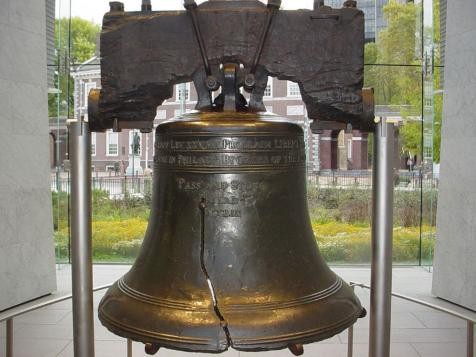
To listen to today’s reflection as a podcast, click here
The most famous story associated with the Liberty Bell is heart-touching.
The elderly bell ringer in Philadelphia’s Independence Hall had lost faith in the Founding Fathers. Would anything come of this dream called America?
But on July 4, 1776, his grandson – having heard the news of the approval of the Declaration of Independence – raced to his side and shouted, “Ring, grandfather, ring!” With that, the gigantic bell began tolling the news that the colonists had declared their freedom.
The joyful sounds drew a crowd. They became the first to hear the Declaration read aloud.
It’s a great story.
Unfortunately, almost none of it is true.
What we know for sure is that the Liberty Bell is a beloved symbol of America’s earliest days.
You can find it on the back of coins, including (at various times) the quarter, half dollar, and silver dollar. It currently graces the reverse side of the $100 bill. Astronaut Gus Grissom honored the Liberty Bell by so naming his Mercury 7 capsule. And what schoolchild doesn’t know that the bell features the world’s most famous crack?
But the Liberty Bell, which weighs a ton and is almost 12 feet around at the base, has had a bit of a cracked history.
It was forged in England and delivered to Philadelphia in 1752. Before it was hung in the steeple, it was given just one test ring.
A bit of the rim immediately splintered. The bell’s metallurgical “mix” of 70% copper, 25% tin, and 5% lead, zinc, arsenic, gold and silver was apparently defective, leaving it too brittle.
Two American metalworkers, John Pass and John Stow (who had never before recast a bell), did their best to make things right. The result produced a truly jarring sound – as one witness reported, “like two coal scuttles being banged together.” Since this was clearly not the result everyone had been anticipating, Pass and Stow gave it another shot. Their second effort was an improvement. The bell was finally hung – a process that took six months.
It’s certain the bell didn’t ring on July 4. Historians are divided as to whether it actually rang on July 8, the day the Declaration of Independence was read aloud in Philadelphia. Records reveal that bells all over the city were sounded that day.
According to the National Park Service, the Pass and Stow bell was subject to “hard use” for the next 90 years. No one knows for sure how, when, and why the famous crack appeared.
In 1837, it finally became known as the Liberty Bell. That happened for two reasons.
The first is the Bible verse that has always been inscribed on its side: “Proclaim liberty through all the land unto all the inhabitants thereof” (Leviticus 25:10).
Second, in the 1830s, the bell became an enduring symbol for the abolitionist movement. American colonists had originally declared their freedom from England. Now who needed to receive the gift of freedom? America’s slaves.
The Liberty Bell hasn’t been rung for a least a century and a half. Every now and then, however, it is gently tapped – annually on Martin Luther King, Jr’s birthday, for instance.
There was an electrifying announcement on April 1, 1996, that the Liberty Bell had been purchased by the Taco Bell corporation, which promptly renamed it the Taco Liberty Bell. According to national press releases, the bell would spend six months every year at the fast food company’s headquarters in Irvine, California.
Independence National Historical Park in Philadelphia was immediately besieged by calls from apoplectic Americans. Was nothing sacred? Officials hastily called a press conference to say they knew nothing of this development. That’s when Taco Bell executives pointed out, no doubt with a smile, that the whole thing was just an April Fool’s joke.
It should be noted that sales of tacos and cheesy gordita crunches rose by more than a half million dollars that week.
It does seem ironic that one of the most cherished symbols of our freedom can’t do the very thing it was created to do: make noise. It is essentially a silent witness to our nation’s birthday, which might be described as the noisiest day of the year.
But we can do what we were created to do. We can decide not to be silent:
Give thanks: For all of the drama and imperfections associated with our nation, it’s still an incredible place. Thank God for the privilege of living in history’s longest-enduring democracy.
Be civil: Depressed by the rancor and pettiness so often on display in our leadership? Choose to go a different way this holiday weekend. Be a living model of grace. Extend a hand and a word of blessing to someone with whom you disagree.
Speak up: As recent months have revealed, freedom is still a work in progress for all too many Americans, let alone myriad citizens of the world who yearn for freedom and are hoping that America can become the best version of itself. This is not the time to be silent about the rights and needs of those on life’s margins. “Proclaim liberty through all the land…”
The Liberty Bell may not be able to ring, but we can step into the gap.
This year, on our nation’s birthday, make a joyful noise unto the Lord (Psalm 100:1).
